Ross Drakes
Creative Director
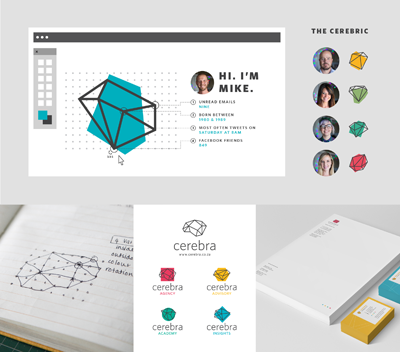
Cerebra, a logo that designs itself
Primary design concentration:
Graphic design, Communication of Ideas and Solutions
Most preferred tools for designing:
I love my Evernote Moleskine
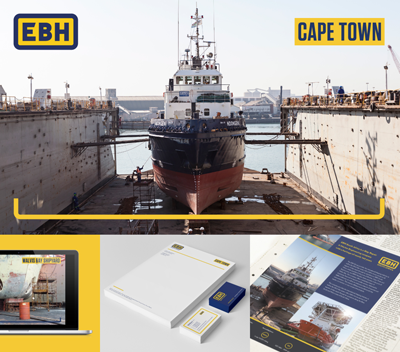
Rebranding and naming of “Elgin Brown and Hamer,” a ship repair company that services South Africa
How and why did you choose to become a designer?
I was always a creative person, or as some of my family would tell me: a crazy person. I love the idea of being able to take an idea and give it a form. After traveling the world for a few years, in the early 2000s, I moved back to take up a course in Brand Communication at Vega. After a stint as an broadcast designer, Flash developer, and freelance designer, I started Nicework in 2007 with two friends: Ben Vorster and Donovan Pugh. Eight years later, Nicework is going strong. Helping clients like Telkom, Standard Bank, Cerebra, and Nike to craft their branding and positioning, and improve their marketing and sales collateral to connect with their audience. Communication and branding are some of the most influential forces in our modern society, and it is really inspiring to be in this field. Everything is always shifting and changing, but the fundamental principals always stay the same.
I have also been told that I don’t like to be told what to do, and design seemed like an easy way to be my own boss.
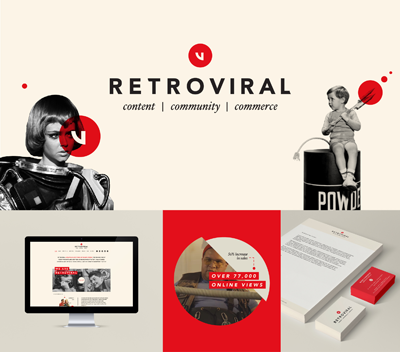
Retroviral rebrand
What are some of the challenges you encounter as a designer and how do you deal with them?
I think demonstrating value is becoming more and more important. Sites like Fivrr are becoming more and more popular. I think they are slowly commoditising design. Execution and beautiful pictures are slowly being sold for less and less.
The only thing we have left is our ideas and the impact that they can have. I think this proposes an interesting challenge for designers—one where we have to put in a bit more effort to craft a clever solution to a problem. To quote Stefan Sagmeister: “Art just is; Graphic Design has to work.” I think we need to use our design thinking to solve communication problems and craft clever messages that truly speak to our clients audiences. This will drive true value. The visualisation becomes the vehicle to deliver your ideas.
What is your definition of an “elegant solution,” that is, good design?
I love seeing design that is so simple and clever, you get that “I wish I had thought of that” moment. When it is so pure and simple, you could not take anything else away from it, but at the same time, it says everything that it needs to say. Generally, if it looks like it it took two minutes to make, but you know that the designer spent many hours and countless revisions to get there.
I also think that an elegant solution is something that communicates across a broad range of people, not just to other creative people. If your friends, mother, grandfather, and a stranger in the street can identify with your design solution. It is elegant.
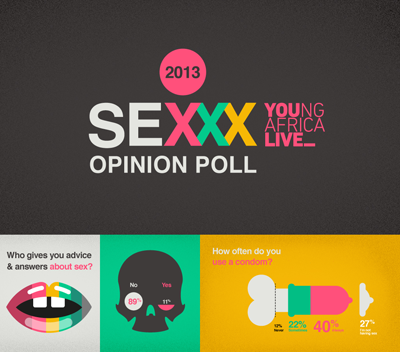
Young Africa Live Sex Survey: design and animation of statistics from their annual survey
From skills to values, what makes a designer successful?
I think designers must be many things to survive today:
Time management → We use Harvest
Basic business acumen → The simplest of which is you need more money coming in than going out
Great tools → Basecamp, Slack, Xero, Evernote
Have a basic set of values, let them guide the work you take
and the decisions you make
A splash of insanity
A hungry mind → Never stop learning
Be a participator, get involved
Never let go of the fun
Give back a little → We run the Johannesburg chapter of CreativeMornings
Consistency
Oh… and clients
A last note → Never be afraid to fire a crappy client.
How do you stay motivated and grow personally and professionally as a designer?
Increasingly matching my work to the strategy of the client. I like to measure my success in how much work has impacted my client’s business in a positive way. Are we saving them time? Getting them more clients? Simplifying their communications? If the answer is yes, then that makes me happy. I love that our clients trust us with precious insight and information into their business, and they look to us to help solve really important problems. I get to meet very clever people and work with them to make a difference to their worlds. Designers get to wear multiple hats and dip our toes into different worlds. We get insight that very few people out there have an opportunity to get. The scope of industries, people, and companies I have been exposed to as a result of my work, keeps me inspired.
I also have collected about 300 half-finished side projects currently not finished with. Starting another with Little Sun.
For those aspiring to become a designer, whatever the discipline, what is your advice?
Find a mentor. There are people in front of you who have learnt the hard lessons. They have done and seen things that you have not. I was very lucky to learn from some talented people (David Minaar, Lerryn Smit, Louis Gavin). It is amazing how much people are willing to teach you if you are keen (and persistent). Also surround yourself with talented and wonderful people who do things that inspire you.
I think the major obstacle for designers is overcoming the gap between your taste and your skill. The only way you can do this is with time, practice, and experience.
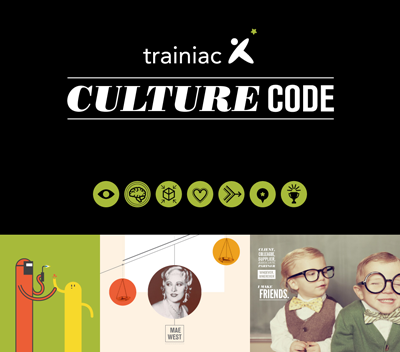
Trainiac company values presentation
What is your quest in design, from a professional practice, education or evolution standpoint?
As designers and communicators, we have the ability to reach millions of people with new ideas. Organisations like CreativeMornings, IDEO, and TED, are great examples of this. Creativity is not a side line process, it can add real value to the world and to business. I would like to see creative people being involved at every stage of a project, and not just at the end when it come time to sell it. As we share our ideas more openly, companies will begin to see the value in creativity and the value it can add to their business.
There is no one who knows what is going on. Everyone is just running around pretending to be adults.
Previous: Juli Watson | Next: Jennifer Lucey-Brzoza

Support this solo initiative
What began as a collection of links has evolved into a comprehensive archive committed to creative culture—offering so far 395 interviews with under-the-radar Artists, Designers & Makers, in addition to 202 write-ups across events, books, movies, more. Free to explore. Free from ads. If you gain a level of motivation, knowledge, even delight, from Design Feast, please support on Patreon. Thanks for your consideration!
Wishing you continual success,
Nate Burgos, Content Creator & Publisher
Comments
There are no comments yet.
Leave Your Comment